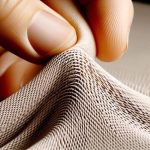Hey there, curious about the infamous shrinking potential of viscose fabric? You're not alone! Knowing how to care for your viscose garments can make all the difference in preserving their shape and size.
In this guide, you'll master the art of handling viscose, from washing and drying techniques to ironing and storing tips. We'll also delve into managing stains and extending the lifespan of your viscose fabric.
By the end, you'll be equipped with top-notch fabric care strategies to keep your viscose looking its best for the long haul. Let's dive in and ensure your viscose stays in top-notch condition!
Key Takeaways
- Machine drying viscose garments can cause shrinkage and loss of softness.
- Hand washing is recommended for viscose garments to preserve their quality and shape.
- Hang viscose clothing on padded or wide hangers to prevent wrinkles and maintain shape.
- Understanding specific care requirements is crucial for viscose blends to prevent shrinkage.
Understanding Viscose Fabric
If you're wondering about the properties of viscose fabric, it's important to understand its composition and characteristics.
Viscose, also known as rayon, is a versatile and popular fabric known for its silky appearance and feel. It's a semi-synthetic material made from regenerated cellulose fiber, often derived from wood pulp or bamboo. This gives it excellent breathability and a smooth, cool texture, making it a great choice for clothing, especially in warmer weather.
Viscose fabric has several desirable properties, such as its ability to drape beautifully, making it ideal for flowy garments. It also absorbs dyes well, resulting in vibrant and rich colors. However, it's important to note that viscose can be prone to wrinkling, so it may require more care when it comes to storage and maintenance.
When it comes to fabric care techniques, it's crucial to follow the manufacturer's instructions. Generally, viscose should be hand-washed or machine-washed on a delicate cycle with a gentle detergent. Avoid using hot water or high heat when drying, as this can cause the fabric to shrink. Instead, opt for air drying or using a low heat setting.
Additionally, to minimize wrinkles, it's best to store viscose clothing items by hanging them rather than folding. Understanding these properties and care techniques will help you maintain the quality and longevity of your viscose garments.
Washing Viscose Garments
When it comes to washing your viscose garments, gentle hand washing is key to preserving their quality and shape.
Avoid machine drying, as the heat can cause the fabric to shrink and lose its softness.
Taking these simple steps will help ensure that your viscose pieces stay looking great for longer.
Gentle Hand Washing
When washing viscose garments, you should always handle them gently to avoid causing any damage or shrinking. Gentle hand washing is the best method for cleaning viscose fabrics while minimizing the risk of shrinkage. Here's how to do it effectively:
- Use lukewarm water and a mild detergent to gently hand wash the garment.
- Avoid wringing or twisting the fabric, instead gently press out excess water.
- Lay the garment flat on a clean towel and carefully reshape it to its original dimensions.
By following these steps, you can ensure that your viscose garment maintains its quality and shape while being effectively cleaned.
This method is a crucial aspect of fabric care and shrinkage prevention for viscose garments.
Avoid Machine Drying
To prevent shrinking, avoid machine drying viscose garments. Air drying is the best method for preserving the integrity of viscose fabric. When machine drying, the high heat can cause the fibers to shrink and lose their shape. Instead, gently squeeze out excess water after hand washing and then lay the garment flat on a drying rack.
If you must use a hanger, make sure it's padded to prevent stretching and distortion. Additionally, avoid using fabric softeners as they can leave a residue on the fabric, affecting its texture and breathability.
Drying Viscose Fabrics
To properly dry viscose fabrics, use a gentle cycle in your washing machine and opt for air-drying or laying the fabric flat to maintain its shape and prevent potential shrinkage.
When air drying viscose fabrics, follow these tips to ensure the best results:
- Avoid Direct Sunlight: Direct sunlight can cause colors to fade and weaken the fibers of viscose fabrics. Choose a shaded or indoor area for air-drying.
- Use a Towel for Absorption: After washing, gently press the fabric with a towel to absorb excess water. Avoid wringing or twisting the fabric, as this can damage the fibers.
- Lay Flat to Dry: To maintain the shape of the garment, lay the viscose fabric flat on a clean, dry surface. Reshape the garment if necessary to prevent any stretching or misshaping.
It's important to note that viscose fabrics are often labeled as dry clean only. If you're unsure about air drying or laying flat to dry, consider professional cleaning to ensure the best care for your viscose garments.
Ironing and Steaming Viscose
To prevent wrinkles and ensure a smooth finish, iron or steam your viscose fabric using a low to medium heat setting. When ironing viscose, it's crucial to place a damp cloth between the iron and the fabric to prevent direct contact, as viscose can be sensitive to heat. Begin ironing from the inside of the garment to avoid creating a shine on the outer surface. Always move the iron gently and avoid pressing too hard to prevent stretching or misshaping the fabric.
When it comes to steaming techniques, using a handheld steamer is an excellent option for refreshing and removing wrinkles from viscose fabrics. Hang the garment and gently glide the steamer over the fabric, maintaining a slight distance to prevent direct contact. This will help to release wrinkles without causing any damage to the delicate fibers. Additionally, be cautious not to over-steam, as excessive moisture can affect the shape of the fabric.
In both ironing and steaming, it's essential to test a small, inconspicuous area of the fabric first to ensure that the heat or steam won't cause any adverse effects. With these ironing precautions and steaming techniques, you can keep your viscose garments looking pristine and well-maintained.
Storing Viscose Clothing
When storing your viscose clothing, it's important to keep it in a cool, dry place away from direct sunlight and moisture to maintain its quality and prevent any potential damage. Here are some tips to help you store your viscose clothing properly:
- Hang It: Use padded or wide hangers to hang your viscose clothing. This helps prevent wrinkles and maintains the garment's shape.
- Avoid Overcrowding: Allow enough space between garments in your closet to prevent excessive wrinkling. Overcrowding can lead to creases that are hard to remove.
- Ventilate: Air out your viscose clothing from time to time, especially if they've been in storage for a while. This can help prevent musty odors and allows the fabric to breathe.
Dealing With Viscose Stains
If you notice a stain on your viscose clothing, promptly address it to prevent it from setting in. Stain removal from viscose requires gentle yet effective techniques to maintain the fabric's delicate nature.
Begin by carefully blotting the stain with a clean cloth to lift as much of the substance as possible. Avoid rubbing, as this can work the stain deeper into the fabric.
Once you've blotted the stain, assess the type of stain and follow the appropriate treatment method. For water-based stains, such as juice or tea, try using a mixture of mild detergent and water to gently dab at the stain. Oil-based stains, like grease or makeup, can be treated with a mild solvent or liquid dish soap.
Remember to always test any cleaning solution on a small, inconspicuous area of the fabric first to ensure it doesn't cause damage.
After treating the stain, wash the garment according to the care instructions. Proper stain removal and fabric maintenance will help keep your viscose clothing looking fresh and beautiful.
Handling Viscose Blends
Handling viscose blends requires careful attention to washing and drying temperatures to prevent shrinkage and maintain the fabric's quality. When dealing with viscose blends, it's essential to understand the specific care requirements to ensure longevity and performance.
Here are some important tips to consider:
- Blending with Spandex: Viscose blends often incorporate spandex to add stretch and elasticity to the fabric. When washing, be mindful of the spandex content as it requires gentle handling to maintain its stretch and recovery properties.
- Dyeing Techniques: Viscose blends are often dyed using different techniques to achieve desired colors and patterns. It's crucial to follow the care instructions specific to the dyed fabric to prevent color fading or bleeding during washing.
These considerations are vital for preserving the integrity of viscose blends. By understanding the unique characteristics of these fabrics and implementing proper care techniques, you can extend the lifespan of your garments and maintain their original look and feel.
Extending Viscose Fabric Lifespan
To extend the lifespan of your viscose fabric, carefully follow the recommended washing and drying temperatures, ensuring gentle handling to prevent shrinkage and maintain its quality.
When washing viscose fabric, use cold water and a mild detergent to prevent pilling and maintain the fabric's softness. Avoid wringing or twisting the fabric, as this can cause distortion and weaken the fibers. Instead, gently press out excess water and lay the fabric flat to dry. Additionally, consider hand washing or using the delicate cycle on your washing machine to minimize wear and tear.
In terms of preventing pilling, consider turning the viscose garment inside out before washing to reduce friction with other items in the load. This simple step can help maintain the fabric's smooth surface and prevent the formation of unsightly pills.
Furthermore, it's essential to consider the environmental impact of caring for viscose fabric. By following the recommended care instructions and extending the lifespan of your garments, you can reduce the frequency of purchasing new items, contributing to a more sustainable approach to fashion. Always strive to make conscious choices that support both the longevity of your viscose fabric and the well-being of the environment.
Frequently Asked Questions
Can Viscose Fabric Be Dyed at Home?
Yes, you can DIY dye viscose fabric at home. Ensure to test color fastness first. Follow fabric care instructions for best results. For stain removal, treat promptly with gentle, non-bleaching solutions.
What Is the Best Way to Remove Wrinkles From Viscose Fabric Without Ironing or Steaming?
To remove wrinkles from viscose without ironing or steaming, try natural alternatives like hanging the garment in a steamy bathroom or using a wrinkle release spray. These quick fixes are effective and gentler on the fabric.
Are There Any Specific Laundry Detergents or Fabric Softeners That Work Best for Viscose?
For viscose, use a mild detergent and avoid fabric softeners to maintain color fastness. When home dyeing, choose dyes specifically made for cellulose fibers. Always follow care labels and avoid high heat.
Can Viscose Fabric Be Tailored or Altered Easily?
Tailoring viscose fabric is feasible, but it requires precision due to its delicate nature. Altering can be done with care, as viscose is prone to shrinkage. Home dyeing is possible, but be cautious as viscose can be tricky to dye evenly.
How Can I Prevent Pilling on My Viscose Blend Clothing?
To prevent pilling on your viscose blend clothing, try gentle wash cycles, using a garment bag, and turning the clothes inside out. Air drying instead of using a dryer can also help maintain the fabric's integrity.
- The Use of Nonwovens in Construction and Civil Engineering - July 11, 2025
- The Use of Nonwovens in Construction and Civil Engineering - July 11, 2025
- The Use of Nonwovens in Construction and Civil Engineering - July 11, 2025





